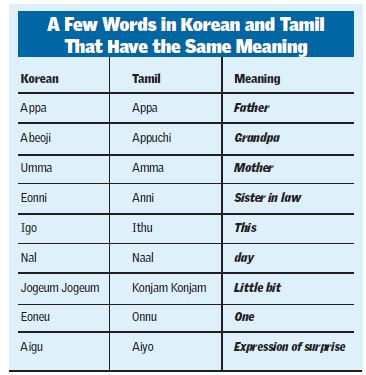
Chennai :
Just as Prime Minister Narendra Modi was recalling the age-old cultural and business relations between South Korea and India in Seoul on Monday, Kyungsoo Kim, Consul General of South Korea in Chennai, revealed that his country indeed had a link with Tamil Nadu from the first Century AD., at a function held at Fort St George. Speaking at the inauguration of exhibition titled Museums of India and Korea, Kim said strong evidence to this connection lay in the common words used in Korean and Tamil languages even today. He narrated an interesting incident that took place just a day before, on Sunday, when he was visiting Mahabalipuram. As he was walking along the sea-shore, Kim heard his son calling him. When he turned back, he realised that it was not his son, but another child who was calling him Appaa. He learned, to his surprise, that the two languages shared some common words.
In all, he claimed, there were around 4,000 words in Korean and Tamil that had similar meaning, indicating the age-old connection between the two countries. It was the French missionaries in Korea who first noted the similarities between the two languages. Many of the names of ancient colonies of Southern Korea were the exact counterparts of Tamil words. Exhaustive as it is, linguistic similarities were not all. The Consul General pointed out that the way both people built their hutments were the same, so were some of the household utensils like ural (a heavy stone or wooden mortar) and ulakkai (long heavy wooden pestle). Experts say that agriculture, pottery, beads, textile, turtle boats, and many ancient industries and cultures in the two countries have stunning similarities.
These similarities, they add, are not coincidences. Early Tamil people migrated to the Korean peninsula around the first century AD, noted N Kannan, Orissa Balu and Dr Nagarajan, all experts on the topic.
The connect between the two cultures is believed to have started way back in CE 45, from the period of King Suro and Hok and Ayi of Pandian Kingdom. Incidentally, King Suro’s kingdom was named Karak, which has a Tamil (proto-Dravidian) meaning fish. “This view was confirmed by the Centre for Korean Studies at the University of Hawaii. Both languages are agglutinative, follow the subject-object-verb order, nominal and adjectives follow the same syntax, particles are post positional, modifiers always precede modified words are some of the common features,” they say.
Inaugurating the photo exhibition, R Kannan, secretary, Culture, Museums, Tourism and Religious Endowments Departments, recalled the strong cultural connection between the two countries.
Earlier, Consul General Kim released a CD on the museums in Tamil Nadu for the student community. K Moortheeswari, Deputy Superintending Archaeologist, Archaeological Survey of India, said the CD would be distributed to all schools in Tamil Nadu free of cost if they approached the Fort St George museum.
The theme of this year’s International Museum Day is ‘Museums for a sustainable society’. It highlights the role of museums in raising public awareness about the need for a society that is less wasteful, more cooperative and that uses resources in a way that respects living systems, she added.
The exhibition will be on till the end of May.
source: http://www.newindianexpress.com / The New Indian Express / Home> Cities>Chennai / by T. Muruganadham / May 20th, 2015
